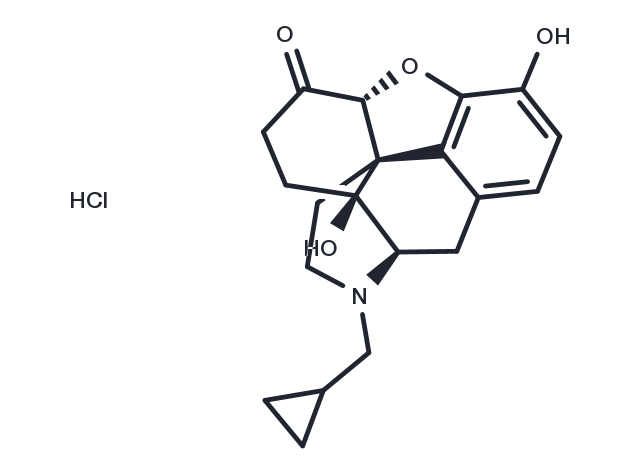Powder: -20°C for 3 years | In solvent: -80°C for 1 year


Naltrexone hydrochloride (Naltrexone HCl) is a synthetic opioid antagonist used in the prevention of relapse of opiate addiction and alcoholism.

| Pack Size | Availability | Price/USD | Quantity |
|---|---|---|---|
| 100 mg | In stock | $ 50.00 | |
| 200 mg | In stock | $ 63.00 | |
| 500 mg | In stock | $ 114.00 |




| Description | Naltrexone hydrochloride (Naltrexone HCl) is a synthetic opioid antagonist used in the prevention of relapse of opiate addiction and alcoholism. |
| Targets&IC50 | Opioid receptor:8 nM |
| In vivo | Naltrexone (0.32 mg/kg) reduces ethanol-reinforced responding at the concentration that maintained the most responding (1% or 2%) in rhesus monkeys. Naltrexone (0.1 mg/kg) reduces ethanol-reinforced responding, both at a low ethanol concentration (0.25%) that produced little ethanol intake (g/kg), and at a higher concentration (4%) with an appreciable intake. [1] Naltrexone (1-3 mg/kg) potently and dose-dependently inhibits reinstatement of ethanol-seeking produced by non-contingent deliveries of the liquid dipper filled with 8% ethanol. [2] Naltrexone elicits optimal enhancement of morphine's antinociceptive potency in mice when co-administered (i.p.) at about 100 ng/kg together with morphine (3 mg/kg). [3] Naltrexone (10 ng/kg i.p.) augments the antinociception produced by an acute submaximal dose of intrathecal (5 mg) or systemic (7.5 mg/kg i.p.) morphine in the tail-flick test in rats. Naltrexone combined with Morphine inhibits the decline in morphine antinociception and prevented the loss of morphine potency in rats. [4] Naltrexone significantly suppresses ethanol self-administration and prevents ethanol-induced increases in dialysate dopamine levels. [5] Naltrexone completely prevents the reduction in anogenital distance in prenatally stressed (PS) males and restores the growth rate of both sexes. Naltrexone also decreases the anxiety of PS rats in the plus-maze, increases the opioid component of exploration to control levels, but increases anxiety in control males. [6] |
| Kinase Assay | Chub-S7 cells are incubated in DMEM containing cold DHEA (20 nM) and tritiated DHEA (0.2 μCi/well) for 48 h. Following incubation, steroids are extracted using dichloromethane separated by thin-layer chromatography using n-hexane/1-hexanol (75:25) as the mobile phase system. Metabolites are identified by comigration with unlabeled reference steroids that are visualized by exposure to Lieberman-Burchard reagent (ethanol-acetic anhydride-sulfuric acid). Steroid conversion is quantified using a LabLogic AR-200 scanner. Protein concentration is measured using a colorimetric 96-well plate assay and used to normalize conversion. Activity is expressed as percent conversion[2]. |
| Synonyms | Depade, Trexan, Naltrexone HCl, Antaxone |
| Molecular Weight | 377.862 |
| Formula | C20H24ClNO4 |
| CAS No. | 16676-29-2 |
Powder: -20°C for 3 years | In solvent: -80°C for 1 year
DMSO: 55 mg/mL (145.56 mM)
H2O: 37.1 mM
You can also refer to dose conversion for different animals. More
bottom
Please see Inhibitor Handling Instructions for more frequently ask questions. Topics include: how to prepare stock solutions, how to store products, and cautions on cell-based assays & animal experiments, etc.
Naltrexone hydrochloride 16676-29-2 Endocrinology/Hormones GPCR/G Protein Neuroscience Opioid Receptor Depade Trexan Naltrexone HCl Naltrexone Hydrochloride Antaxone inhibitor inhibit
